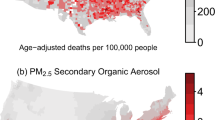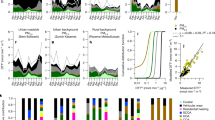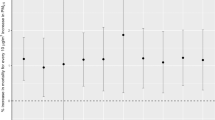Abstract
This paper presents the results of a study in Melbourne, Australia, of the short-term effects of ambient fine particle pollution on daily mortality occurring between 1991 and 1996. The methodological approach used Poisson regression and Generalized Additive Models (GAM) with LOESS smoothing to control for temporal and meteorological effects. The association between particles and increases in daily mortality was examined using nephelometry data (bsp, mean 24 h average=0.26×10−4 m−1, mean 1 h maximum=0.60×10−4 m−1), PM2.5 (24 h mean=9.42 µg/m3) and PM10 (24 h mean=19 µg/m3). Both the PM10 and PM2.5 data were estimated from nephelometry data using previously derived relationships for the Melbourne airshed. Significant positive associations between the particle measures considered and all cause and respiratory mortality were found in the warm season (November–March). A 1×10−4 m−1 increase in maximum 1-h bsp levels was associated with a 2.19% (95% CI=0.01–4.43%) increase in risk of death for all cause mortality and a 10.40% (95% CI=2.44–18.97%) increase in risk for respiratory mortality in the warm season. A 1 µg/m3 increase in 24-h PM2.5 in the warm season was associated with a 0.38% (95% CI=0.06–0.70%) increase in risk of death for all cause mortality and a 1.18% (95% CI=0.05–2.32%) increase in risk for respiratory mortality. For PM10, a 1 µg/m3 increase was associated with an increased risk of 0.18% (95% CI=0.03–0.33%) for all cause mortality and 0.59% (95% CI=0.06–1.13%) for respiratory mortality. Significant associations were also found in the 65+ age group in the warm season. However, for these warm periods, the effects of ozone (average 1 h maximum=127 ppb) and nitrogen dioxide (average 1 h maximum=70.7 ppb) were also significant and, due to high correlations between these pollutants, it was not possible to separate the particle effects from those of O3 and NO2. Sulfur dioxide was not examined as concentrations of this pollutant in Melbourne are very low (max 1 h=15–24 ppb, annual average 0.8 ppb). Comparison with other Australian studies in Sydney and Brisbane indicates different results for particle pollution.
This is a preview of subscription content, access via your institution
Access options
Subscribe to this journal
Receive 6 print issues and online access
$259.00 per year
only $43.17 per issue
Buy this article
- Purchase on Springer Link
- Instant access to full article PDF
Prices may be subject to local taxes which are calculated during checkout
Similar content being viewed by others
Author information
Authors and Affiliations
Corresponding author
Rights and permissions
About this article
Cite this article
SIMPSON, R., DENISON, L., PETROESCHEVSKY, A. et al. Effects of ambient particle pollution on daily mortality in Melbourne, 1991–1996. J Expo Sci Environ Epidemiol 10, 488–496 (2000). https://doi.org/10.1038/sj.jea.7500137
Received:
Accepted:
Published:
Issue Date:
DOI: https://doi.org/10.1038/sj.jea.7500137
Keywords
This article is cited by
-
Associations between ambient air pollution and daily emergency department attendances for cardiovascular disease in the elderly (65+ years), Sydney, Australia
Journal of Exposure Science & Environmental Epidemiology (2006)
-
A time-series study of air pollution, socioeconomic status, and mortality in Vancouver, Canada
Journal of Exposure Science & Environmental Epidemiology (2003)



